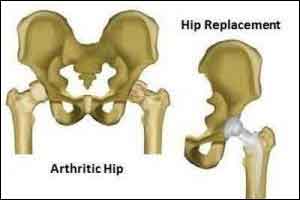- Home
- Editorial
- News
- Practice Guidelines
- Anesthesiology Guidelines
- Cancer Guidelines
- Cardiac Sciences Guidelines
- Critical Care Guidelines
- Dentistry Guidelines
- Dermatology Guidelines
- Diabetes and Endo Guidelines
- Diagnostics Guidelines
- ENT Guidelines
- Featured Practice Guidelines
- Gastroenterology Guidelines
- Geriatrics Guidelines
- Medicine Guidelines
- Nephrology Guidelines
- Neurosciences Guidelines
- Obs and Gynae Guidelines
- Ophthalmology Guidelines
- Orthopaedics Guidelines
- Paediatrics Guidelines
- Psychiatry Guidelines
- Pulmonology Guidelines
- Radiology Guidelines
- Surgery Guidelines
- Urology Guidelines
'Dual mobility' hip replacement implant has less risk of dislocation : Study

Total hip replacement is a highly successful procedure but has a common complication of dislocation which may require revision surgery. Dr.Geoffrey Westrich, research director of the Adult Reconstruction and Joint Replacement Service at Hospital for Special Surgery (HSS) conducted a study and has found that patients who received a newer implant known as a "dual mobility" hip replacement had zero dislocations as compared to patients who received a traditionally fixed bearing hip implant who had a dislocation rate of 5 percent.The research has been presented at the American Academy of Orthopaedic Surgeons Annual Meeting in New Orleans.
Although the concept of dual mobility was originally developed in France in the 1970s, the technology is relatively new in the United States. "Dual mobility" refers to the bearing surface of the implant - where the joint surfaces come together to support one's body weight.
More than 330,000 total hip replacements are performed in the United States each year. Overall, it is a highly successful procedure. However, as with all surgeries, a risk for complications exists.We were especially interested in seeing how the younger patient population fared because they are generally more active and put more demands and stress on their hip after joint replacement, and this increases the risk of dislocation," Dr. Westrich explained.
A hip replacement implant is a ball-and-socket mechanism, designed to simulate a human hip joint. Typical components include a stem that inserts into the femur (thigh bone), a ball that replaces the head of the thigh bone, and a shell that lines the hip socket.
"Dual-mobility hip components provide an additional bearing surface," Dr. Westrich explains. "A large polyethylene plastic head fits inside a polished metal hip socket component, and an additional smaller metal or ceramic head is snap-fit within the polyethylene head. Dual mobility means that there are two areas of motion, improving the range of movement and reducing the risk of dislocation."
Dr. Westrich and colleagues compared the dual mobility system with the traditional fixed bearing system in two age-matched groups of patients who had a primary total hip replacement over the same time period. There were 136 patients in each group with a mean age of 48.
At three-year follow-up, the researchers found that the patients who received the dual mobility implant had no dislocations. In the group receiving the standard fixed bearing implant, seven patients, or 5.1 percent, had a dislocation and needed a revision surgery.
"Total hip replacement is increasingly being performed in younger patients," Dr. Westrich said. "The results of our study are encouraging for this active, high demand group of patients and may lessen concerns for dislocation. More research is needed to see how dual mobility implants perform over the long term."

Disclaimer: This site is primarily intended for healthcare professionals. Any content/information on this website does not replace the advice of medical and/or health professionals and should not be construed as medical/diagnostic advice/endorsement or prescription. Use of this site is subject to our terms of use, privacy policy, advertisement policy. © 2020 Minerva Medical Treatment Pvt Ltd